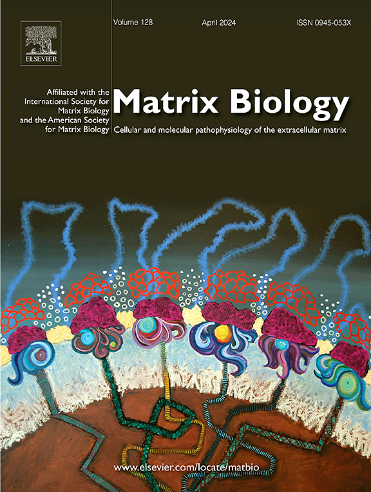大疱性结缔组织表皮松解角质形成细胞微环境的改变:一项基因表达研究。
IF 4.8
1区 生物学
Q1 BIOCHEMISTRY & MOLECULAR BIOLOGY
引用次数: 0
摘要
整合素α6β4亚基和XVII型胶原是参与皮肤细胞-基质粘附的关键跨膜蛋白,而层粘连蛋白332是它们在基底膜区(BMZ)的配体。这些蛋白参与半粒酶(hd)的组成,其相应基因的致病变异导致大疱性结缔组织表皮松解症(JEB)。虽然人们已经广泛研究了JEB的基因型-表型关系,但基因突变导致的细胞外基质(ECM)和细胞-基质粘附的病理变化尚不清楚。我们使用大量RNA测序(RNA-seq)对选定的JEB供体来源的细胞系进行了全球无偏倚转录组分析,这些细胞系分别缺乏整合素β4亚基(ITGB4-)、XVII型胶原(COL17-)和层粘连蛋白β3链(LAMB3-)。额外的JEB细胞系和JEB供体皮肤样本用于验证相关发现。总的来说,结果显示ITGB4-和COL17-细胞系中ECM和局灶黏附(FAs)相关基因的失调模式相似,而LAMB3-细胞表现出相对相反的趋势。重要的是,失调网络中的关键节点与参与伤口愈合过程的ECM蛋白相关。此外,一组炎症相关基因在JEB角化细胞中被上调,并且不能通过粘附修复而正常化。功能分析进一步揭示了突变细胞系COL17->ITGB4->LAMB3-之间稳定粘附的等级关系,这种等级关系与其临床表现的严重程度有关。我们的结果表明,伤口愈合相关的ECM和炎症微环境是由JEB角化细胞建立的。本文章由计算机程序翻译,如有差异,请以英文原文为准。
Alterations in the microenvironment of junctional epidermolysis bullosa keratinocytes: A gene expression study
Integrin α6β4 subunits and type XVII collagen are critical transmembrane proteins involved in cell-matrix adhesion in skin, while laminin 332 serves as their ligand in the basement membrane zone (BMZ). Those proteins contribute to the composition of hemidesmosomes (HDs) and pathogenic variants in their corresponding genes cause junctional epidermolysis bullosa (JEB). Although the genotype-phenotype relationships in JEB have been extensively studied, the pathogenetic changes of extracellular matrix (ECM) and cell-matrix adhesion resulting from gene mutations remain unclear. We conducted a global unbiased transcriptome analysis using bulk RNA sequencing (RNA-seq) on selected JEB donor-derived cell lines lacking integrin β4 subunit (ITGB4-), type XVII collagen (COL17-) and laminin β3 chain (LAMB3-), respectively. Additional JEB cell lines and JEB donor skin samples were used for validation of relevant findings. Collectively, the results revealed similar dysregulation patterns of ECM and focal adhesion (FAs) associated genes in ITGB4- and COL17- cell lines, while LAMB3- cells displayed a relatively opposite tendency. Importantly, key nodes in the dysregulated network were associated with ECM proteins involved in wound healing processes. Additionally, a group of inflammatory-associated genes was disclosed to be up-regulated in JEB keratinocytes and could not be normalized by the adhesion rescue. The functional assay further revealed the hierarchy of stable adhesion among mutant cell lines COL17->ITGB4->LAMB3-, which correlates with the severity of their clinical manifestations. Our results indicated a wound healing associated ECM and inflammatory microenvironment established by JEB keratinocytes.
求助全文
通过发布文献求助,成功后即可免费获取论文全文。
去求助
来源期刊

Matrix Biology
生物-生化与分子生物学
CiteScore
11.40
自引率
4.30%
发文量
77
审稿时长
45 days
期刊介绍:
Matrix Biology (established in 1980 as Collagen and Related Research) is a cutting-edge journal that is devoted to publishing the latest results in matrix biology research. We welcome articles that reside at the nexus of understanding the cellular and molecular pathophysiology of the extracellular matrix. Matrix Biology focusses on solving elusive questions, opening new avenues of thought and discovery, and challenging longstanding biological paradigms.
 求助内容:
求助内容: 应助结果提醒方式:
应助结果提醒方式:


